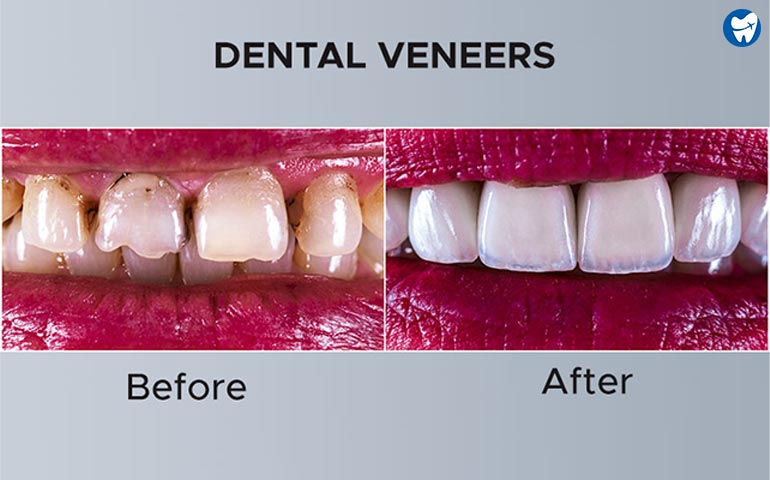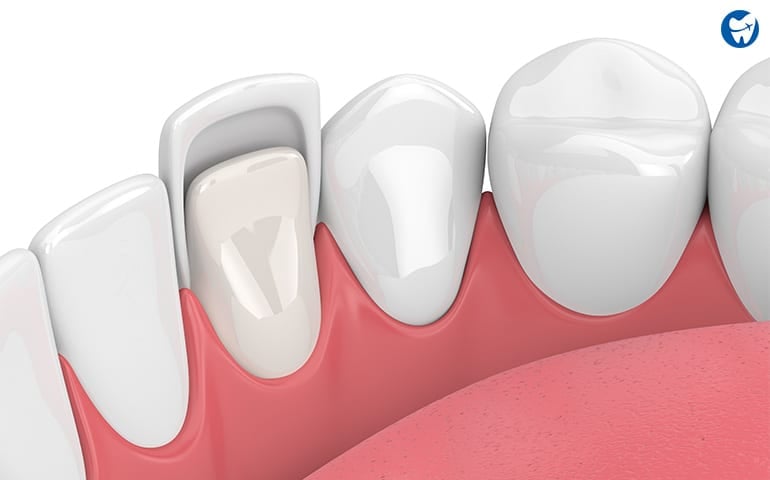Before you opt for low-cost dental veneers abroad, it is important to know: what is a dental veneer? Dental veneers are thin tooth colored shells which are custom-made to fit onto a patient’s prepared teeth. They are usually made of composite or porcelain.
Restorative aesthetic dentistry has been around for a very long time. One of the major components of restorative aesthetic dentistry is dental veneers.
The newer approach in this genre, however, is about providing excellent aesthetics as conservatively as possible.
Veneers before and after
Based on their strength, longevity, conservative nature, biocompatibility, and aesthetics, veneers are considered an excellent treatment modality for creating ideal smiles since their introduction in 1983.
The world we live in today has developed a growing focus on aesthetics.
Cosmetic Dentistry, which is one of the foremost aspects of facial aesthetics, has been ushered to new heights.
When Would You Need Dental Veneers?
A smile is worth a thousand words. If you are not satisfied with your smile down, dental veneers can most likely help fix it.
Here are the 5 most common cases where dental veneers could be the treatment of choice:
1. Discoloration
Staining of teeth is highly prevalent. There are several different causes of tooth staining including:
It occurs on the inside of the tooth.
For example, if the internal live tissue of the tooth (pulp) has been damaged due to bacterial infection, the tooth might appear discoloured.
Some intrinsic stains occur during early childhood. These include fluoride and tetracycline staining, or stains due to conditions like enamel hypoplasia.
This means that the stain is on the exterior surface of the tooth. There can be various kinds of extrinsic stains.
Given below are the various colored extrinsic stains and their probable causes: [1]
- Brown- Excessive consumption of tea, coffee
- Dark brown- Tobacco chewing or smoking
- Black- Iron-containing drugs and Color-producing (Chromogenic) bacteria
- Other foods and drinks like red wine, sodas, and berries can lead to staining as well.
2. Chipped or Broken Tooth
Front teeth sometimes tend to chip or break under undue pressure.
3. Minor Malalignment
In certain situations, slightly misaligned and misshapen teeth can actually be made to look straight by placing veneers.
It is best to consult with a dental professional to see if orthodontics is a better option.
- If the teeth have proper shape but minor malalignment, orthodontics would be the treatment of choice as teeth do not require trimming.
- If the teeth are improperly shaped or require minor correction in alignment, veneers may be the better option for both defects.
4. Diastema Closure
A diastema is a space between two teeth. Mostly, it is seen in between the two front teeth. This space can be efficiently covered up by using veneers.
5. Worn Down Teeth
Some people suffer from a condition called Bruxism, in which they grind their teeth against one another, mostly at night.
This leads to the wearing down of the chewing surfaces of teeth.
Here, aside from the cosmetic correction, functional correction is also required. Only after this can any cosmetic treatment be successful.
Source- Healthline [2]
Veneers
Types of Dental Veneers
There are 5 main types of veneers used in practice nowadays:
- Composite is a material that can be used directly or indirectly. In its direct usage, the dentist will first apply the material to your tooth and then contour, cure and polish it.
- The indirect method involves fabricating the veneer on a model of the patient’s teeth and then bonding it to the tooth surface using adhesives.
- Composite veneers are the most economical option of the two, but the downside is that the material tends to catch stains easily.
- Also, they have lower strength, which means that they are more prone to chipping or breaking under stress. There is a higher possibility that you will need replacement after a few years as opposed to porcelain veneers.
- Also known as traditional veneers, these are the most commonly used ones in practice.
- While they do need about 0.5mm of reduction which is limited to the enamel, they last a considerable amount of time in most cases.
- Lumineers is a brand of veneers that is more conservative.
- The thickness of this shell is less than that of the porcelain veneers. This allows them to be placed on top of the natural tooth without any trimming (or in certain cases, minimal contouring).
- Some patients do complain of the tooth feeling bulkier after lumineers, but this is a rare occurrence.
- They are typically used in cases where a patient will have small teeth with minor spacing between them.
- CEREC is a CAD/CAM system (computer-aided design/ computer-aided manufacturing) which allows a prosthesis of desired dimensions to be carved out of a block of ceramic.
- Instead of making an impression, a special camera is used to take a 3-D image of the prepared tooth.
- The restoration is carved out accordingly by a computer.
- The main advantages here are the accuracy of fit, good esthetics, and you can get the final restorations in just one appointment without the need for temporaries.
- One of the recent breakthroughs in dentistry has been the introduction of zirconia.
- It has been used to fabricate crowns, veneers, and even implants.
- The USP of the material is its immense strength which will impart longevity to the prosthesis.
- Zirconia lacks translucency so it’s more functional than it is aesthetic. The appearance of the teeth may not look as natural with them.
Comparison of Various Materials for Veneers
Advantages:
- Low cost
- Minimal tooth preparation
Disadvantages:
- Not as long-lasting as other options
- Stain easily
Advantages:
- Great shade matching
- Durable
Disadvantages:
- Long procedure time of at least 2 weeks
Advantages:
- Require no tooth preparation (or very minimal contouring)
- Local anaesthesia is usually not needed
Disadvantages:
- It may make the tooth bulky
Advantages:
- Quicker method
- High accuracy
Disadvantages:
- High Cost
Advantages:
- Very high strength
Disadvantages:
- High cost
- Lacks translucency that affects aesthetics
Dental Veneers Procedure
Dental Veneers Procedures
Examination
✔️ The first step of the procedure is the examination.
✔️ The dentist will physically inspect the stains on your teeth, and after further testing, if required, a conclusion will be drawn as to the nature of the stains.
✔️ Other treatment options like bleaching and enamel microabrasion may also be considered.
✔️ The indications, as well as the preferences of the patient, will dictate the treatment option that is finally chosen.
✔️ The material, too, is selected based on the patient’s requirements, their budget, as well as the functional and aesthetic needs of the teeth.
Enamel Removal
✔️ The second step will be tooth preparation. In cases of traditional porcelain veneers, typically about 0.5mm of enamel is removed.
✔️ The success of the porcelain veneer is greatly determined by the strength and durability of the bond formed between the three different components of the bonded veneer
✔️ These are the tooth surface, the porcelain veneer, and the luting composite.
✔️ In this step, the tooth surface is prepared so that it holds onto the cement with its full capacity.
Making impressions
✔️ After removing the appropriate amount of tooth structure, an impression of the tooth is made.
✔️ This will act as a reference for the fabrication of the final prosthesis.
✔️ In cases of CAD/CAM veneers, no impressions are needed. Rather, scans of the teeth are taken and the veneers are milled by a machine.
Choosing the Shade
✔️ At this stage, your dentist will show you a shade guide.
✔️ There are numerous shades available to choose from nowadays.
✔️ Depending on multiple factors like the colour of your adjacent natural teeth, as well as your personal preference, a decision is made, and your final veneer is fabricated.
If you plan on whitening your teeth, this should be done before the shade selection.
Wait at least one week after completion of whitening for shade stabilization of the natural teeth.
Keep in mind that any previous ceramic/porcelain/metal restorations do not change shade.
Dental Veneer Shade Selection
Fixing Temporary Veneers
✔️ Depending on which tooth is being treated and the needs of the patient, temporary veneers might be needed in some cases.
✔️ In certain situations where only minimal contouring of the natural teeth is needed, temporaries are not required.
✔️ In case a temporary solution is provided you have to be careful while eating as they are cemented with temporary cement. They might come off or chip while chewing on hard food.
Final Appointment
✔️ In your next appointment, the prepared final veneers are first tried without the bonding cement.
✔️ This helps to assure a proper fit and establish if further changes are needed.
✔️ When the patient and the dentist are both satisfied, a tooth-coloured adhesive cement is used to secure the veneer in place.
✔️ Any excess adhesive cement is removed and the bite will be checked to make sure everything feels comfortable and natural.
Source- Healthline [3]
How Much do Veneers Cost Abroad for Your Teeth?
The prices of dental treatment in countries such as the USA, the UK, Canada, Australia, and New Zealand are through the roof. However, we have a solution to this problem – dental tourism.
Dental treatments are provided in popular dental tourism destinations at 50-80% lower prices with the same quality of care!
Let’s see the prices of dental veneers in some of these countries:
Dental Veneers Cost Abroad
| Country | Composite Veneer Cost | Porcelain Veneer Cost |
|---|---|---|
| USA | $1,500 | $2,500 |
| Canada | $1,200 | $2,300 |
| UK | $700 | $1,300 |
| Australia | $570 | $1,900 |
| New Zealand | $200 | $1,250 |
| Hungary | $100 | $370 |
| Mexico | $45 | $350 |
| Thailand | $40 | $570 |
| Costa Rica | $85 | $425 |
| Colombia | $190 | $270 |
| Turkey | $120 | $275 |
While a composite veneer in the United States costs $250 to $1500, its price is only $45 in Mexico and $85 in Costa Rica. In Thailand, dental veneers cost only $40 to $50.
Porcelain veneers on average cost between $920 to $2,500 per tooth in the United States. Porcelain veneers in Mexico are priced at $350 each.
Mexico, Thailand, and Costa Rica happen to be some of the preferred dental tourism destinations for a relaxing beach vacation.
We provide excellent dental care in all three of these countries.
Can't afford dental veneers back at home?
Save upto 70% abroadTop 10 Locations for Dental Veneers Abroad

Mexico
Mexico is one of the most captivating & charming cities to explore. It has 26 UNESCO-declared world heritage sites.
Save up to 92% on dental veneers in Mexico. Discover more on our Top 10 Dental Clinics and Dentists in Mexico page.

Costa Rica
With biodiversity & abundant wildlife, Costa Rica is an eco-tourist's paradise.
Save 80% on porcelain teeth veneers in Costa Rica. For exact costs, visit Top 10 Dental Clinics and Dentists in Costa Rica

Colombia
Colombia, with its rich cultural heritage, offers diverse attractions, from serene Caribbean beaches to the eternal spring of Medellin.
To learn more, check these blogs - Dental Tourism in Colombia, Top 10 Dental Clinics and Dentists in Colombia

Turkey
Turkey offers everything from ancient ruins to vibrant nightlife, not to mention a diverse range of culinary delights.
Save 80% on dental veneers in Turkey. Explore more on the Top 10 Dental Clinics and Dentists in Turkey page.

Croatia
Discover a plethora of experiences in Croatia, from exploring lush green forests to kayaking in open blue waters.
Save 75% on dental veneers in Croatia. Visit Top 10 Dental Clinics and Dentists in Croatia for pricing and top destinations.

Romania
Besides the iconic castles popularized by Bram Stoker’s Count Dracula, Romania offers much more to explore.
For more details, check out the Dental Work in Romania and Top 10 Dental Clinics and Dentists in Romania blogs.

Hungary
Hungary is known for its architectural treasures from Roman ruins to Baroque churches.
Learn about prices and the best places for treatment in these blogs – Dental Work in Hungary and Top 10 Dental Clinics and Dentists in Hungary.

Bulgaria
Tourists go to Bulgaria to see the mesmerizing blend of nature, history, art, nightlife, and culture.
If you are interested in Bulgaria veneers, check out these blogs – Dental Work in Bulgaria and Top 10 Dental Clinics and Dentists in Bulgaria.

Albania
Albania, with ancient Greek & Roman remnants, stunning beaches & lush greenery, is an ideal vacation destination.
To know prices & destinations, read these blogs: Dental Tourism in Albania and Top 10 Dental Clinics and Dentists in Albania.

El Salvador
The incredible diversity of flora & fauna makes it a perfect getaway if you seek serenity & tranquility.
To learn more about the procedure & providers, check these blogs - Dental Tourism in El Salvador & Top 10 Dental Clinics and Dentists in El Salvador
Conclusion
We hope that this guide curated by us helps you find the alternative that fits you the best when it comes to low-cost dental veneers abroad.
If you have any other queries, contact us right away, and we will be happy to assist you.
FAQ’s on Dental Veneers Abroad
We have curated a list you can refer to know how much the cheapest veneers cost (porcelain):
- Mexico- $350
- Costa Rica- $425
- Colombia- $270
- Turkey- $275
Check out the table below to choose an ideal location to get cheap veneers abroad:
Cheapest Countries for Veneers
| Country | Cost |
|---|---|
| US | $2,500 |
| Mexico | $350 |
| Costa Rica | $425 |
| Colombia | $270 |
| Turkey | $275 |
Choose the location that suits you the best
Plan my dental trip





